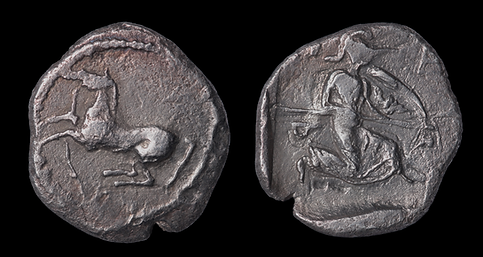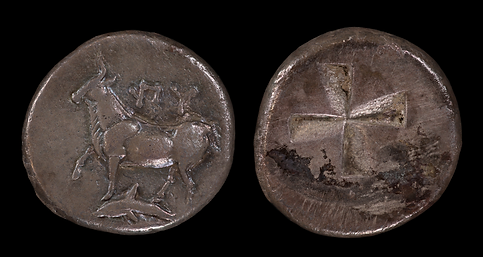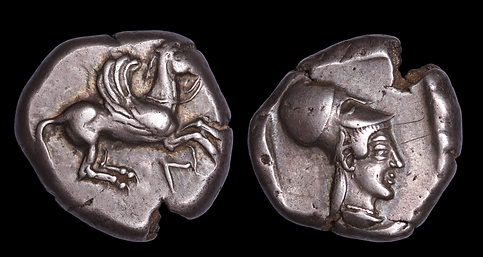
Diomedes Ancient Coins
Coins of Greece & the Islands

Achaia, Achaian League. Pallantion. Hemidrachm, 88-30 BC, 16.0mm 2.23g Obv: Laureate head of Zeus right. Rev: AX monogram. Rev. Π-A-Λ, trident and AN monograms, all within laurel wreath.

Islands off Attica, Aegina. AR Stater, circa 525-480 BC. Obv: Sea turtle, head in profile, with thick collar [and makers mark on its back]. Rev: Incuse square of 'Union Jack' pattern with three sections filled.

Attica, Athens, AR tetradrachm with test strike. c420 BC. Obv: Helmeted head of Athena right. Rev: AΘE, Owl standing right, head facing, olive sprig behind. 23.4mm 17.31g

Attica, Athens. Circa 165-42 BC. Tetradrachm (Silver, 33 mm, 16.90 g, 12 h), 140/39. Obv: Head of Athena Parthenos to right, wearing triple-crested Attic helmet adorned with Pegasos and long tendril on the bowl, and with the foreparts of four horses above the visor. Rev: A-ΘE Owl standing facing on Amphora; to left, monogram; to right, aphlaston above monogram; in exergue, ΣΦ; all within laurel wreath.

Boeotia, Tanagra. Obol (early-mid 4th century BC). Obv: Boeotian shield. Rev: ΤΑ Forepart of a horse to right. Weight: 0.86g. Diameter: 9.5mm.

Boiotia, Thebes AR Drachm. Circa 525-480 BC. Obv: Boeotian shield. Rev: Incuse square with counter-clockwise mill-sail pattern. 5.82g, 15mm.

Boeotia, Thebes. Circa 395-338 BC. Stater (Silver, 23 mm, 11.95 g), Charo..., magistrate, circa 379-368. Obv: Boeotian shield. Rev. ΨΑ-RO Amphora; above, ivy wreath; all within shallow incuse.

Boeotia, Thespiai. Obol (4th century BC). Obv: Boeotian shield. Rev: ΘΕΖΠΙ. Two horizontal crescents back to back. Weight: 0.70 g. Diameter: 10 mm.

Corinthia, Corinth. Silver drachm, circa 350-285 BC. Obv: Pegasos flying right, Ϙ below. Rev: head of Aphrodite right with hair in sakkos. Die Axis: 9h. Diameter: 13 mm. Weight: 2.31 g

Corinthia, Corinth. Stater (Circa 375-300 BC).Obv: Pegasos flying left; koppa below. Rev: Helmeted head of Athena right. Controls: club and N to left. Weight: 8.74 g. Diameter: 23 mm.

Elis, Olympia. 134th-143rd Olympiad, circa 244-208 BC. Drachm (Silver, 20 mm, 4.64 g, 10 h). Obv: Eagle flying right, grasping the back of a hare with his talons. Rev: F-A Winged thunderbolt with double volutes.

Euboia, Chalkis. Circa 338-308 BC. Drachm (Silver, 17 mm, 3.56 g, 10 h). Head of the nymph Chalkis to right, wearing pendant earring and necklace and with her hair rolled. Rev. XAΛ Eagle flying to right with open wings, pecking at snake held in its talons; to right, kerykeion.

Lesbos, Mytilene, EL hekte. 454-427 BC. Obv: Forepart of boar Rev: lion’s head right.

Lesbos, Mytilene circa 521-478 BC. Sixth Stater or Hekte EL. 11 mm, 2.56 g. Obv: Head of a ram to right; below, rooster standing right, pecking at the ground; to lower right, [ΛΕ]. Rev: Incuse head of a bull to right.

Islands off Ionia, Samos. Circa 512 BC. AR Triobol (10mm, 1.48 g, 12h). Samian standard. Obv: Head of panther facing within pelleted square. Rev: Head of ox left in linear and pelleted border within incuse square.

Macedonia, Acanthus. Tetrobol circa 500-480, AR 16 mm, 2.51 g. Obv: Forepart of a bull left, head right; above, acanthus flower. Rev: Quadripartite incuse square

Macedon, Akanthos, Tetrobol, 470-390BC. Obv: Forepart of bull left, head looking back ΠE above; Rev: Shallow quadripartite incuse square

Macedonia, First Meris AR Tetradrachm. Amphipolis, circa 167-149 BC. Obv: Diademed and draped bust of Artemis to right, bow and quiver over shoulder, in the centre of a Macedonian shield. Rev: Club; monogram and MAKEΔONΩN above, ΠPΩTHΣ and two monograms below; all within oak wreath, thunderbolt to left. 16.89g, 33mm, 12h.

Macedonia, Eion. Circa 480-470 BC. AR diobol (0,83 g). Obv: Goose stepping left, head right, lizard above. A in lower left field. Rev: Quadripartite incuse square.

Macedonia, Olynthos. Chalcidian League (432-348 BC). AR Tetrobol, 2.26 g, 16 mm Obv: Head of Apollo left
Rev: Lyre in incuse, Χ-Α-Λ-ΚΙΔ-ΕΩΝ.

Sikyonia, Sikyon - AR Triobol (c. 330-280 BC, 2.71 g). Obv: Chimera advancing left, raising forepaw, ΣI below Rev: Dove flying left

Thessaly. Thessalian League circa 470-460 BC. Hemidrachm AR.14 mm, 2.97 g. Obv: Forepart of horse right, emerging from rock. Rev: ΘΕ-ΤΑ (retrograde), grain ear within incuse lozenge.

Thessaly, Lamia. Hemidrachm (circa 350-300 BC). Obv: Head of Dionysos left, wearing ivy wreath. Rev: ΛΑΜΙΕΩΝ. Amphora; ivy leaf above, prochous with handle to right; all within incuse circle. Weight: 2.61 g. Diameter: 13.5 mm.

Thessaly, Larissa circa 400-360 BC. Drachm AR. 20 mm, 6.04 g. Obv: Thessalos, with cloak and petasos over his shoulders, leaping left, both feet off the ground, holding a rushing bull by a band around its head. Rev: ΛΑΡΙ / ΣΑΙΑ, bridled horse with trailing rein galloping to right; all within shallow incuse square.

Thessaly, Pharkadon. Circa 440-400 BC. Hemidrachm (Silver, 17 mm, 2.81 g, 12 h). Obv: Hero, nude and with petasos and chlamys flying behind his back, running right and holding a band with both his hands passing around the head of a bull's forepart to right. Rev. Φ-A/P Forepart of a horse to right; all within shallow incuse square.

Thessaly (Pherrabia), Perrhaboi c. 450-430 AC. (12mm, 0,74g, 12h) Obv: Horse, with bridle on its neck, leaping to the left; circular beading. Rev: Retrograde legend Helmeted Athena wearing a chiton, running to the right, brandishing a javelin across with her right hand and holding a shield in her left hand; all within the remnants of a hollow square

Thessaly, Skotussa. Drachm, 465-460BC. Obv: Forepart of horse running left. Rev: Grain seed in incuse square.

Thrace, Byzantium. Drachm circa 340-310, AR 15.00 mm., 5.17 g. Obv: Cow standing left; below, dolphin and above ΠY. Rev: Quadripartite incuse square.

Thrace. Maroneia. Circa 398/7-386/5 BC. Triobol (Silver, 15 mm, 2.66 g, 6 h). Obv:E-Y-Π Forepart of horse to left. Rev. Μ-Α Grape bunch on vine, within dotted square border; all within shallow incuse square.

Thrace, Mesembria. Diobol (Circa 420-320 BC). Obv: Facing helmet. Rev: M - E - T - A. Four-spoked wheel.

Islands off Thrace, Thasos. Circa 148-90/80 BC. Tetradrachm (Silver, 31 mm, 16.66 g, 1 h). Head of youthful Dionysos to right, wearing tainia and wreath of ivy and fruit. Rev. HΡAKΛEOΥΣ - ΣΩTHΡOΣ / ΘAΣIΩN Herakles standing front, head to left, holding club in his right hand and lion skin draped over his left arm and shoulder; in inner left field, monogram

Acarnania. Leucas. Circa 470–450 BC. AR Stater (19 mm, 8.49 g). Obv: Pegasus flying right; below, Λ. Rev: Head of Athena right, wearing Corinthian helmet; all within partially incuse square.

Attica, Athens. Circa 430s-420s BC. Tetradrachm (Silver, 24 mm, 17.19 g, 4 h). Obv: Head of Athena to right, wearing crested Attic helmet decorated with three olive leaves and palmette. Rev. AΘE Owl standing right, head facing; to left, olive sprig and crescent; all within incuse square.

Attica, Athens. Circa 450-404 BC. AR drachm (16mm, 4.13 gm, 7h). Obv: Head of Athena right, wearing crested Attic helmet ornamented with three laurel leaves and vine scroll. Rev: AΘE, owl standing right, head facing; olive sprig with berry behind, all within incuse square.

Boeotia, Orchomenos, circa 475-425 BC. AR Obol (8mm, 0.81 g.). Obv: Wheat grain, sprouting end upward; E-P across central field. Rev: Aeginetan-style skew pattern incuse.

Boeotia, Thebes. AR-Stater, 480 - 460 BC; 11.88 g. Obv: Boeotian shield. Rev: Incuse square with 'mill-sail' device. archaic Θ.

Boeotia. Thebes. Silver stater, circa 425-395 BC. Obv: Boeotian shield. Rev: bearded head of Dionysos right, wearing ivy-wreath; Θ-Ε across fields; all within incuse square.

Boeotia, Thebes. Circa 425-375 BC. Hemidrachm (Silver, 12 mm, 2.61 g). Obv: Boeotian shield. Rev: ΘE-BH Kantharos; above, club to right.

Boeotia, Thespiai. Early-mid 4th century BC. Obol (Silver, 11 mm, 0.84 g, 2 h). Boeotian shield. Rev. ΘΕΣ Crescent composed of three lines.

Corinthia, Corinth. Circa 375-300 BC. AR Stater (8.56g, 21mm). Obv.: Ϙ Pegasos flying left. Rev.: head of Athena to left, wearing Corinthian helmet; below chin, A; behind neck guard, Λ and trophy.

Corinthia, Corinth. Circa 500-450 BC. Stater (Silver, 20 mm, 8.43 g, 12 h). Obv: Ϙ Pegasos with curled wing flying to right. Rev. Helmeted head of Athena to right; behind, crescent and Ϙ; all within incuse square.

Euboea. Euboean League. Ca. 304-290 BC. AR drachm (16mm, 4.66 gm, 12h). Obv: Head of the nymph Euboea left, hair rolled, wearing triple-pendant earring. Rev: EY, filleted head of bull right; bunch of grapes to right.

Illyria, Apollonia. Drachm, 250-48 BC, 3.24g 17.0mm Obv: Maarkos (magistrate) above cow standing left suckling calf, monogram below. Rev: AΠOΛ ΛYΣHNOΣ around double stellate pattern.

Lesbos, Mytilene circa 521-478 BC. Sixth Stater or Hekte EL. 10 mm, 2.54 g. Obv: Lion's head right. Rev: Bull's head right within incuse square.

Islands off Caria, Rhodes, didrachm c.387-304 BC. Obv: Head of Helios facing, turned slightly right, hair parted in centre and swept to either side. Rev: POΔION, rose with single bud on tendril to right; grape bunch in left field, E to right of stem.

Islands off Troas , Tenedos AR Drachm. Circa 450-387 BC. Obv: Janiform head of female, facing left, and bearded male, facing right Rev: Labrys; grape bunch to lower left, thymiaterion to lower right, TEN-EΔ-I-ΩN around. 3.67g, 16mm, 12h.

Macedonia, Alexander I (498-454 BC). Tetrobol. Obv: Horse prancing right. Rev: Crested helmet right within linear border within incuse square. Weight: 1,97 g Diameter: 14 mm.

Macedonia, Time of Philip V and Perseus, 187-168 BC. Tetrobol (Silver, 14 mm, 2.44 g, 10 h), Pella or Amphipolis. Obv: Macedonian shield; on boss, MA-KE above and below club. Rev: Macedonian helmet to left; to left and right, three monograms; to lower right, thunderbolt.

Macedon, 187-168 BC. AR tetrobol (15mm, 2.12 gm, 1h). Pella or Amphipolis mint. Obv: Macedonian shield with six rotating crescents in boss. Rev: MAKE / ΔONΩN, prow of galley right; P in right field.

Macedonia, Neapolis, Hemidrachm, 424-350 BC Obv: Facing Gorgoneion. Rev: Nymph head right, legend at right.

Sikyonia, Sikyon. Silver Stater (12.00 g), ca. 335-330 BC. Obv: ΣE below, chimaera prowling left; above, wreath. Rev: Dove flying left; before, I; all within wreath.

Thessaly, Thessalian League. AR-Stater, late 2nd - mid-1st century BC, magistrates Cephalos and Themisto(...) Obv: Head of Zeus with laurel wreath on the right. Rev: Athena Itonia striding with shield and lance on the right. 6.06 g.

Thessaly, Kierion, AR Trihemiobol. Late 4th century BC. Obv: Head of nymph Arne to right. Rev: Arne kneeling to right, head to left, playing knuckle bones; KIEPI-EIΩN around. 1.43g, 14mm, 9h.

Thessaly, Larissa. Drachm. Approx. 356 - 320 BC. Obv: Head of the nymph Larissa with ampyx (woman's diadem) en face, turned slightly to the left. Rev: Horse, grazing, standing right, left foreleg raised. 19mm 6.11g

Thessaly, Larissa. Circa 380-365 BC. AR Drachm (19.5mm, 6.16 g, 9h). Obv: Head of the nymph Larissa facing slightly left. Rev: Mare and foal standing right.

Thessaly, Pharsalos. Late 5th-mid 4th century BC. AR Drachm (19.5mm, 6.00 g, 5h). Dies signed by Telephantos. Helmeted head of Athena right; small TH/IΠ between crest and neck guard. Rev: Warrior, wearing petasos, holding lagobolon over his shoulder, on horseback right; small TH in exergue; all within incuse square

Thessaly, Skotussa (circa 465-460 BC) AR Hemidrachm (13mm, 3.08g, 11h). Obv: Forepart of horse right, Rev: Germinating barley-grain surrounded by S-K-O ethnic, all within incuse square, 3.08g. From The 'Kyrios' Collection

Thessaly, Trikka AR Hemidrachm. Circa 440-400 BC. Obv: Thessalos, nude but for petasos and cloak tied at neck, holding band around head of forepart of bull to right. Rev: Forepart of bridled horse to right; ΤΡΙ-Κ-ΚΑI-ΟΝ (retrograde) around; all within shallow incuse square. 2.87g, 17mm, 8h.

Thracian Chersonese - Hemidrachm or tetrobole Obv: Protome of a lion leaping to the right, turning its head to the left. Rev: Quadripartite hollow square with two hollow and two relief sections, decorated with a globule, and an insect Reverse legend: Date: c 350 BC Mint name / Town : Cardia, Thrace Diameter: 13 mm Orientation dies: 6 h Weight: 2.35 g

Thrace, Maroneia. Tetradrachm (Circa 189/8-49/5 BC).Obv: Head of Dionysos right, wearing ivy wreath. Rev: ΔIONYΣOY / ΣΩTHPOΣ / MAPΩNITΩN. Dionysos standing left, holding grape bunch and narthex stalks. Controls: monogram to inner left and inner right. Weight: 15.67 g. Diameter: 32 mm.

Thrace, Pantikapaion. Æ 310-304 BC. Obv: : head of satyr facing right. Rev: Π-Α-Ν, griffin protome facing left, including sturgeon.